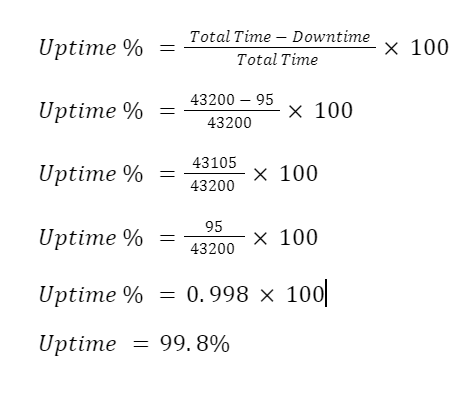
What is an Uptime SLA Guarantee and Should You Have One?
When someone visits your website or logs into your platform, they expect it to be available whenever needed. But downtime is inevitable, whether it’s an unexpected technical hiccup or necessary routine maintenance.
Because of that certainty, tech vendors hold themselves accountable to their clients with an uptime service level agreement (SLA) guarantee. This guarantee sets clear expectations about how often your services will be available and what happens when those expectations aren’t met.
To create an SLA, you and your team must set a target for minimum annual uptime that meets the industry standards clients expect while being realistic with what you can deliver.
But how do you translate those targets into an executable agreement?
We’ll explain the basics of uptime and why it matters, dig into the data needed to create a standard uptime SLA, and break down the math and SLA metrics so that you feel well prepared to decide whether to leverage the agreement as a transparency tool to earn customer trust.
Defining Uptime
What is Uptime? It is a reliability metric in the computing industry that measures how consistently a service is accessible to users. It’s expressed as a percentage that indicates how many minutes out of the year the system is expected to be available and fully operational.
What Is an Uptime SLA?
An uptime SLA is a formal commitment between a service provider and its clients that states the expected availability of the vendor’s service over a given period.
Information typically provided in this document includes:
- The uptime guarantee, discussed below
- Which metrics will be included in the SLA reporting
- Compensation — usually in the form of service credits — should the provider breach the contract
- Situations where the uptime guarantee may not apply, such as during scheduled maintenance or if a force majeure (“act of God”) allows for non-performance due to unforeseen, natural circumstances outside the vendor’s control (hurricane, wildfire, etc.)
What Is an Uptime Guarantee?
We define uptime guarantee as the specific percentage of time a service provider promises their system will be accessible to its users. While the SLA sets the framework for service expectations, the guarantee quantifies the service’s reliability.
With an uptime guarantee, you’re offering your customers confidence that they can depend on your tools for their daily operations. You also demonstrate your willingness to hold yourself accountable if you fall short of meeting those service expectations.
How To Calculate Uptime
You can use a basic formula to figure out the percentage of time your service is functional:
In the SLA uptime formula:
- Total Time is the number of minutes in a particular period, usually a month or year, during which the service is expected to be available
- Downtime is the time the service was unavailable within that same period
So, say, for instance, that your service operates for 43,105 minutes in a 30-day month. A 30-day month has 43,200 minutes total (60 minutes x 24 hours x 30 days), which means the other 95 minutes were downtime.
To calculate the uptime percentage for an SLA, it would be:

Though a 99.8% uptime SLA might seem high, it still means that clients should expect an hour and 35 minutes of downtime every month, which can directly impact their business operations. For that reason, most companies strive for a high uptime guarantee of 99.9% or more.
Why Does Uptime Matter?
For businesses that depend on digital services, uptime is one of the most important factors determining successful operation, as it directly affects revenue and reputation. Even a few minutes of downtime at an inopportune time can seriously damage your brand’s trustworthiness.
Consider this: If unexpected failures cause your uptime percentage to drop to 99.0% — which seems far above average if you’re unfamiliar with the metric — it translates to more than seven hours of downtime each month.
In industries like cloud services and software platforms, expecting users to give up that much productivity time isn’t going to go over well, particularly if you consider that the minimum standard is closer to 99.9%.
Levels of Uptime Guarantees
To help consumers quickly evaluate the cost vs. availability of particular services, uptime guarantees are classified by the number of “nines” in their percentage — the more nines, the more time a specific product or service will be functional during the given period.
99.9% Uptime SLA (Three Nines)
Many services guarantee 99.9% uptime, allowing for roughly 43 minutes and 12 seconds of downtime each month. This is typically considered the industry standard.
Examples of companies that guarantee 99.9% uptime include:
- Google Cloud Standard Tier Data Transfer
- Google Workspace
- The Caspio Low-Code Platform
- Mews Hospitality Management System
99.99% Uptime (Four Nines)
With a 99.99% guaranteed uptime SLA, the allowable downtime drops to just 4 minutes and 19 seconds per month. This level is ideal for businesses that need near-constant availability, such as financial services, healthcare platforms, or large-scale e-commerce sites.
Examples of companies that guarantee 99.99% uptime include:
- Slack
- Azure Active Directory
- Okta Identity Clouds
- DigitalOcean Networking Products
99.999% Uptime (Five Nines)
Considered the gold standard for service reliability, 99.999% uptime means that a system is only down for 5 minutes and 15 seconds per year, making it the standard for emergency response systems.
Otherwise, this level of availability is relatively rare, as it’s expensive to maintain and requires extensive redundancy and failover protocol.
Examples of companies that guarantee 99.999% uptime include:
- Intermedia Cloud Communications
- Stratus Server Systems
- Prisma SASE
- Amazon Web Services Emergency Response Architecture
Should Your Business or Service Have an Uptime SLA?
Deciding whether to implement a guaranteed uptime SLA comes down to a few factors:
What Industry Are You In?
If your clients rely on the uninterrupted availability of your website, service, product, or platform to conduct their own business, then offering a high uptime guarantee shows customers that you’re committed to maintaining a high standard and are willing to take accountability if those standards aren’t met.
You can click through below to see examples of industry-specific SLAs and compare them to your current service offering for more insight into when these uptime guarantees are relevant.
Examples of Uptime SLAs
- Network uptime guarantees cover the availability of data-transmission infrastructure — routers, switches, and other networking hardware — such as the one offered by the Liquid Web SLA.
- Software uptime guarantees are part of the SaaS model so that customers know the product they’re paying for will be available when needed. Adobe Experience Manager offers a 99.99% guarantee in their uptime SLA.
- Hosting companiesprovide server uptime guarantees to assure clients that the underlying physical or virtual servers powering their services will remain online. Hostinger’s “uptime formula” promises the industry standard of 99.9%.
- Cloud uptime guarantees have skyrocketed in importance as more clients rely on cloud infrastructure for everything from casual data storage to running their missing critical applications. The Google Cloud Platform guarantees 99.95% monthly uptime, limiting downtime to approximately 22 minutes.
Are You Capable of Consistently Meeting Those Standards?
Infrastructure matters when evaluating what level of uptime you can guarantee, so sometimes, it’s better to hold off until you’ve invested in some upgrades. Overpromising can lead to costly service credits and affect your online reputation.
The best way to evaluate whether you’re ready is to use a reliable uptime monitoring platform and SLA reporting tool to assess your current capabilities over a year.
What Are Your Competitors Doing?
Online services are incredibly competitive, so if you’re willing to stand behind your service’s performance, one-upping others in the industry can become a tempting selling point.
For example, if competitors of a similar size and price point have a 99.9% uptime guarantee, your offering an SLA promising 99.99% uptime can give you the edge.
However, an SLA might not be necessary in some situations, like if you’re a smaller startup or have internal-facing services where your clients are more forgiving of occasional downtime.
Similarly, if your product is not mission-critical, you may get more competitive value from maintaining a lower cost rather than promising a particular availability.
How To Set Up Your Own Uptime SLA Reporting
It’s easy to set up a Public SLA page through Uptime.com, and in just a few minutes, you’ll have a live display of summary metrics on global uptime, outages, and total downtime for your public or private URL.
- Log in to your Uptime.com dashboard and click “Status Pages” then “New Status Page.” Select “Public SLA Pages.”
- Click the Gear icon > Global Setting and tick the following boxes: “Make this page available publicly.” “Allow search indexing of status page.” Then, “Allow subscribers to this page.”
- Click the Gear icon > Customize Look & Feel. Add the Google Analytics Property ID.
- If desired, upload your custom logo and any custom CSS.
- Once your Public SLA Page is set up, you can share the public-facing page with clients and keep them informed of your service reliability.
Don’t have access to a performance dashboard yet?
Start your 14-day free trial of Uptime.com’s top-rated website monitoring Premium Plan — no credit card required — and immediately set up your own uptime SLA measurement and reporting.
Minute-by-minute Uptime checks.
Start your 14-day free trial with no credit card required at Uptime.com.
 Uptime.com Blog
Uptime.com Blog


